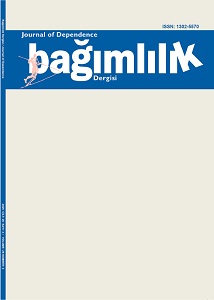IS PRESCRİPTİON DRUG ABUSE İN PRİSONS CHANGİNG? A PRELİMİNARY STUDY WİTH PRİSON DOCTORS
Keywords:
Drug abuse, prisoner, gabapentin, pregabalin, quetiapineAbstract
Objective: Since prescription drug abuse is a serious problem in prison settings, we set out to identify the most abused prescription drugs in prisons by asking primary care physicians employed there.
Method: In our study, 15 physicians were interviewed face to face and 15 physicians were interviewed by e-mail. The survey included questions related to the city where the prison was located, number of inmates, estimated percentage of prescription drug abusers, and the top five prescription drugs most requested of the doctors.
Results: The five most commonly listed drugs in response to the question regarding the doctors’ opinions as to which prescription drugs were the top five abused by prisoners were anti-epileptics gabapentin and pregabalin (80%), anti-influenza drugs containing dextromethorphan (66.6%), pain killers (non-steroidal anti-inflammatory drugs) and muscle relaxants containing phenprobamate (55%), quetiapine (46%), and the anticholinergic drug oxybutynin biperiden (40%).
Discussion: The present study suggests that gabapentin, pregabalin, dextromethorphan, anti-inflammatory drugs, muscle relaxants, and quetiapine are the most abused prescription drugs among convicts. Prescription drug abuse is widely reported among convicts throughout the world.
Conclusion: This study relies upon personal observation of prison physicians. Broader studies related to prescription drug abuse in prisons would lead us to a better understanding of the situation.
References
Şengül AC. İlaç suistimali ve ilaç bağımlılığı. Türkiye Klinikleri J Neu- rol-Special Topics 2010; 3(1) : 199-203.
Simoni-Wastila L, Strickler G. Risk factors associated with problem use of prescription drugs. American Journal of Public Health 2004; 94(2) : 266-268.
Filipetto FA, Zipp CP. Coren JS. Potential for pregabalin abuse or diversion after past drug-seeking behavior. The Journal of the American Osteopathic Association 2010; 110(10): 605-607.
Victorri-Vigneau C, Guerlais M, Jol-liet P. Abuse, dependency and withdrawal with gabapentin: A first case report. Pharmacopsychiatry 2007; 40(1) : 43.
Collopy KT, Friese G. Prescription for danger. Prescription drug abuse is rampant among today’s adolescents; here’s what you need to know about this epidemic. EMS World 2010; 39(12) : 38-45.
Schifano F. Misuse and abuse of pre- gabalin and gabapentin: cause for concern? CNS Drugs. 2014; 28(6): 491-6.
Çiçekçi F, Yükseksavaş D. Mahkûmlar arasında gabapentin kötüye kullanımı. 46.Ulusal Anestezi ve Reanimasyon Ulusal Kongresi Özet Kitabı, 2012 : 224.
Bisaga A, Aharonovich E, Garawi F, et al. A randomized placebo controlled trial of gabapentin for cocaine dependence. Drug Alcohol Depend 2006; 81(3) : 267-274.
Mason BJ, Crean R, Goodell V, et al. A proof-of-concept randomized executive function deficits in cannabis-dependent adult. Neuropsychopharmacology 2012; 37(7) : 1689-1698
Pierre JM, Shnayder I, Wirshing DA, Wirshing WC. Intranasal quetiapine abuse. American Journal of Psychiatry 2004; 161(19) : 1718.
Evren C, Karatepe HT, Aydın A, ve ark. Alkol/ madde bağımlılarında ketiapin etkisi ve kötüye kullanımı: Olgu serisi ve gözden geçirme. Klinik Psikofarmakoloji Bülteni 2009; 19 : 148-154.
Kaya H, Dilbaz N, Okay T, Çeşmeci U. Ketiyapin bağımlılık yapıyor mu? Klinik Psikofarmakoloji Bülteni 2009; 19: 32-36.
Erdoğan S. Madde kullanım bozukluklarında ketiyapinin yeri, kötüye kullanım ve bağımlılık olasılığı: Bir gözden geçirme. Türk Psikiyatri Dergisi 2010; 21(2) : 167-175.
Forrester MB . Dextromethorphan abuse in Texas, 2000-2009. Journal of Addictive Diseases 2011; 30(3) : 243-247.
Reissig CJ, Carter LP, Johnson MW, et al. High doses of dextromethorphan, an NMDA antagonist, produce effects similar to classic hallucinogens. Psychopharmacology 2012; 223(1) : 1-15.
Espi Martinez F, Espi Forcen F, Shapov A, Martinez Moya A. Biperiden dependence: Case report and literature review. Case Rep Psychiatry 2012 doi: 10.1155/2012/949256
Guloksuz S, Eren K, Gurol DT. A case of oxybutinin dependency. Gen Hosp Psychiatry 2010; 32(4) : e5-6.
Kumsar NA, Okay IT, Dilbaz N. Oksi-bütinin kötüye kullanımı ve bağımlılığı: İki olgu sunumu. Klinik Psikofarmakoloji Bülteni 2009; 19(Ek 1) : 1123-1124.
Adams EH, Breiner S, Cicero TJ, et al. Comparison of the abuse liability of tramadol, NSAIDs, and hydrocodone in patients with chronic pain. J Pain Symptom Manage 2006 ; 31(5) : 465-476.
McCabe SE, Boyd CJ, Teter CJ. Subtypes of nonmedical prescription drug misuse. Drug Alcohol Depend 2009; 102(1-3) : 63-70.
Cooper RJ. Over-the-counter medicine abuse–a review of the literature. Journal of Substance Use 2013; 18(2) : 82-107.
Kihara M. Patterns of drug use and HIV-related risk behaviors among incarcerated people in a prison in Iran. Journal of Urban Health 2010; 87(4) : 603–616.
Singleton N, Farrell M, Meltzer H. Substance misuse among prisoners in England and Wales. International Review of Psychiatry 2003; 15(1-2) :150-152.
Downloads
Published
How to Cite
Issue
Section
License
Copyright (c) 2025 Journal of Dependence

This work is licensed under a Creative Commons Attribution-NonCommercial-NoDerivatives 4.0 International License.
...
